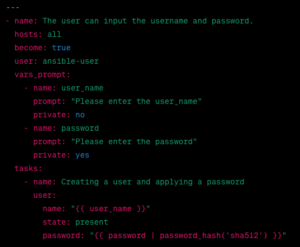While playing around with Ansible playbooks, I ran into a problem that left me scratching my head. I had a playbook to create a new user on a Linux system, complete with a password. Everything seemed fine, but I couldn’t log in with the new user. After spending some time stuck, I got a helpful tip from a well-known Ansible expert, Nehra sir. Turns out, the issue was something small but important.
My playbook was supposed to create a user and set a password. However, even though the user was created, I couldn’t log in – authentication errors were stopping me. It was frustrating! The solution to this puzzle came when I contacted Nehra sir for advice.
Nehra sir took a look at my playbook and spotted a tiny mistake I hadn’t noticed. The problem was with how I encrypted the password. Ansible uses a thing called the password_hash filter to encrypt passwords, and my mistake was putting a space between password_hash and the encryption method.
Fixing the issue was simpler than I thought. All I had to do was remove the space between password_hash and the encryption method. After making this small correction, my playbook worked like a charm. Here’s the corrected part:
– name: Creating a user and applying a password
user:
name: “{{ user_name }}”
state: present
password: “{{ password | password_hash(‘sha512’) }}”
This experience taught me a lot about being careful with the details in Ansible. Sometimes, even a small mistake, like an extra space, can cause big problems. Especially when dealing with passwords and security, it’s essential to pay close attention.
In the end, this journey with Ansible not only improved my technical skills but also reminded me of the importance of being precise in configuration management. Seeking help from experienced folks like Nehra sir and fixing the issue enhanced my understanding of Ansible and how to use it effectively.
Here’s the original playbook that caused the trouble:
—
– name: The user can input the username and password. 
hosts: all
become: true
user: ansible-user
vars_prompt:
– name: user_name
prompt: “Please enter the user_name”
private: no
– name: password
prompt: “Please enter the password”
private: yes
tasks:
– name: Creating a user and applying a password
user:
name: “{{ user_name }}”
state: present
password: “{{ password | password_hash(‘sha512’) }}”
This blog post is my way of sharing this experience and reminding everyone that even the smallest mistakes matter in the world of automation.
Mygithub: https://github.com/devprojects2023